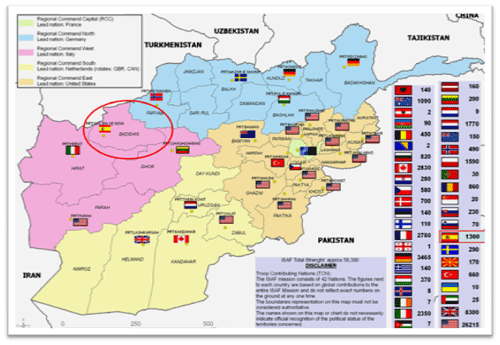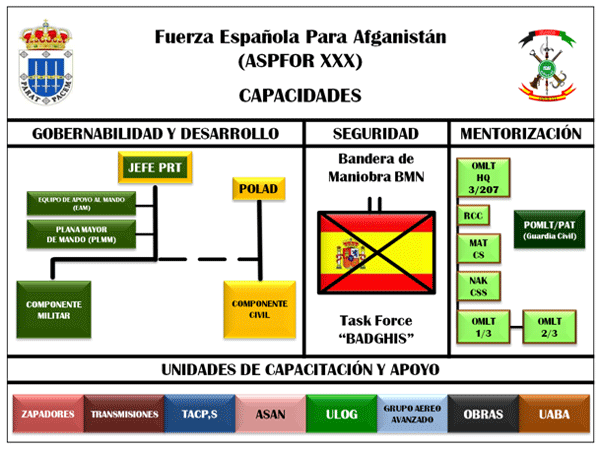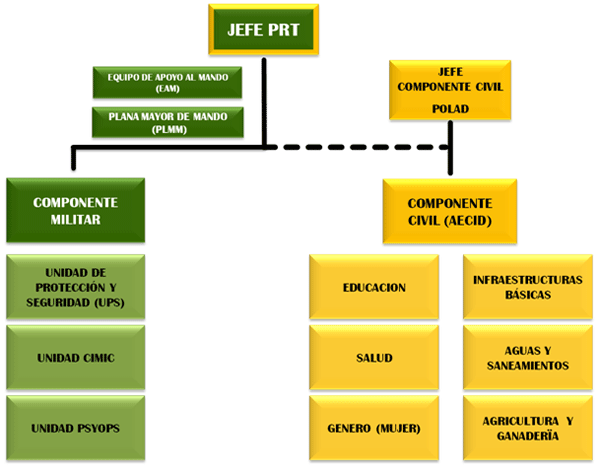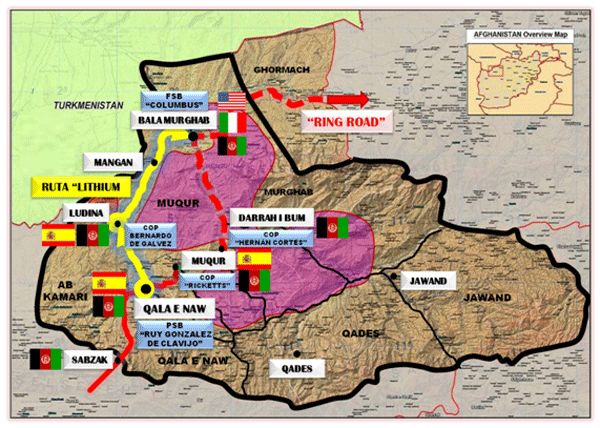- Home
- International Missions
- Afghanistan
- ASPFOR XXX
ASPFOR XXX
ASPFOR (Afghanistan SPanish FORce) XXX is the 30th Spanish Force for Afghanistan. The bulk of the force comes from the Legion Brigade “Rey Alfonso XIII”, which has been deployed in Afghanistan since January 2012 to support the Afghan government so that it can extend its influence and authority over the whole country – specifically, Badghis province.
For the next five months, ASPFOR XXX will continue the work which its predecessors have been doing for the last decade, assisting the legitimate Afghan government in the path towards stability and prosperity.
The force is made up of around 1,300 soldiers, of whom 5% are women and 15%, foreign nationals. Spain has been contributing to this effort since 2002 alongside 47 other countries, integrated into the International Security Assistance Force (ISAF) in Afghanistan led by NATO, in agreement with UN Security Council Resolution 1386/2001.

Structure & Deployment
ASPFOR XXX has its HQ at the Provincial Support Base “Ruy González de Clavijo”, located in the town of Qala-i-Naw, capital of the Badghis province. The base is under the command of a colonel advised by a command team and supported by his Staff officers. He leads the four key bodies with the capacity to act.

In effect, the force is structured into four different bodies, according to the task they perform: The Provincial Reconstruction Team (PRT); the Manoeuvre Battalion “Task Force Badghis”; the operational mentor and liaison teams to the Afghan army and police (OMLTs and POMLTs, respectively); and the enabling and support units. The latter guarantee that the others are fully operational and their needs are covered.
Enabling and support units include the Protection & Security Unit, the Civil-Military Cooperation Unit and the Psychological Operations Unit, as well as the Sappers Unit, the Signals Unit, the Medical Support Unit, the Main Logistic Unit, the Advanced Aerial Group and the Base Support Unit, whose role is essential for the functioning of the base.
Some members of ASPFOR XXX are stationed at the Forward Staging Base “Camp Arena”, near the city of Herat, capital of the region. They include a rear-guard logistic unit and a liaison officer. Similarly, an operational mentor and liaison team (OMLT) has been detailed to another base in Herat, “Camp Stone”, to set up an Afghan Route Reconnaissance and Clearance unit.
As a result of the need to expand security and ensure the governability and development of the Badghis province, which is under Spanish responsibility, ASPFOR XXX keeps two Combat Outposts in the towns of Ludina and Moqur – COP “Bernardo de Gálvez II” and COP “Ricketts”. Both are reinforced companies and constitute the spearhead of the Spanish force in its objective to secure and extend the area of influence of the legitimate government of the province. They act in coordination with the Afghan National Army, either through “partnering”, i.e. taking part in joint operations, or through “mentoring”, which includes the training and advisory tasks performed by the mentoring teams (OMLTs). On April 2012 the area of Darrah-i-Bum was considered pacified and ASPFOR XXX transferred its third COP, “Hernán Cortés”, to the Afghan Army, which is tangible proof that objectives are being fulfilled.
Provincial Reconstruction Team (PRT)
A PRT is a civil-military organisation able to operate in unstable and dangerous areas. It combines diplomatic and military capabilities to create a safe environment and bolster the efforts of the Afghan government by improving the situation of the population and supporting reconstruction and development programmes. Spain contributes the PRT in Badghis, a province in the Herat region.
Badghis, in the northwest of Afghanistan, is one of the most underprivileged provinces in the fourteenth poorest country on Earth. Its weather is extreme, with temperatures ranging from minus 17 degrees Celsius in winter to over 50 in the summer. Its orography is abrupt, which poses serious problems of mobility and, therefore, governability. Over 70% of the adult population is illiterate. There are five different ethnic groups unevenly distributed over the territory. This increases tensions, especially between Pashtuns and Tajiks, and those, in turn, contribute to instability and exacerbate the insurgency.

ASPFOR XXX contributes the military component of the PRT structure, which includes a Protection & Security Unit from the Legion Cavalry Group of Ronda (Málaga); a Civil-Military Cooperation (CIMIC) Unit from the Legion; and a Psychological Operations Unit from the 1st Intelligence Regiment, based in Valencia.
PRT’s civilian component is led by a career diplomat who also acts as a political advisor (POLAD) to the civil-military organisation. He is assisted by personnel from the Spanish Agency for International Development Cooperation (AECID), which is under the authority of the Spanish Ministry of Foreign Affairs. Its main task is to identify, assess and execute projects with a significant social and economic impact which carry direct and long-term benefits for the province. Those projects focus on areas such as basic infrastructures, water and sanitation, health, education, women’s rights, agriculture and animal husbandry.
The CIMIC Unit
As indicated in the description of the Provincial Reconstruction Team, one of its components is a Civil-Military Cooperation Unit. The Spanish Army has been deploying this type of unit for over fifteen years in its main foreign operations, notably Bosnia-Herzegovina, Kosovo, Albania, Iraq and Lebanon. In Afghanistan, it is a key element for the success of the mission.
The chief task of the CIMIC Unit is to support governability and development by engaging the population through their local authorities and launching what is known as Quick Impact Projects (QIPs). These have a real impact on people’s lives and contribute to winning over hearts and minds. They focus on areas such as basic infrastructures (roads, walls, schools…); water and sanitation (wells, cisterns, canalisations…); energy (solar panels); health (medical equipment, refurbishment of health clinics); and emergency humanitarian aid (delivery of food, clothes, shoes…). These actions are identified by the personnel of the CIMIC Unit, then the colonel who leads the Provincial Reconstruction Team presents a plan to Operations Command. If the project is approved, locals are hired to carry it out to further extend its benefit.
The CIMIC Unit also coordinates Spanish lessons to the population, currently attended by more than 200 boys and girls.
The Manoeuvre Battalion: Task Force Badghis
The Spanish force in Afghanistan, ASPFOR XXX, also includes the Manoeuvre Battalion. Stability and progress in Afghanistan rest on three pillars: Security, governability and development. This Battalion, known as Task Force Badghis, has been charged with the security pillar in the area of Spanish responsibility, Badghis province, by the International Security Assistance Force (ISAF) through Regional Command West (RC West). Its main task is, therefore, to provide a safe environment so that the Afghan people and all other national and international actors can work in the area without harm or hindrance.
Task Force Badghis is an infantry-battalion type of unit, with a structure similar to that of regular battalions in Spain. The bulk of its troops come from the 7th Legion Battalion “Valenzuela”, from the Regiment “Don Juan de Austria”, 3rd of the Legion, based at Viator (Almería). Its head is also the commander of ASPFOR XXX.
In any case, the Battalion and its components (three companies of legionnaires and two other companies of Staff officers and services, respectively) are assisted by all the other units which constitute ASPFOR XXX. They provide combat support (sappers, signals and aero-tactical teams) and combat logistics support (medical stabilisation cell, supplies and maintenance).
As explained above under “Structure & Deployment”, the task force operates in three different areas in the Badghis province: In the capital, Qala-i-Naw, it provides security with its presence, takes part in controlling the airport and keeps a reserve unit. It also contributes companies to the Combat Outposts (COPs) “Bernardo de Gálvez II”, in Ludina, and “Ricketts”, in Muqur, guaranteeing freedom of movement through the “Lithium” and “Ring Road” routes respectively, and securing and expanding the security bubbles in both areas of influence.
It is worth mentioning the joint patrols with the Afghan army, aimed at fostering a climate of trust, boosting their credibility and promoting stability.
Mentor & Liaison Teams (OMLTs & POMLTs/PATs)
The mentor and liaison teams are also crucial elements within ASPFOR XXX. They are known as OMLTs or POMLTs; the former work with the Afghan army and the latter, with the Afghan police. They report directly to the commander of the force.
The mentor and liaison teams organise, support, train, advise, liaise with and supervise the Afghan army and police. All of those tasks fall within the scope of the general definition of “mentoring”, hence their name. They make sure that Badghis province will have an army and a police force able to continue the work of our forces, providing security and order to its people.
OMLTs and POMLTs include a significant number of commanding officers and are organised as Spanish organic units. Setting up those teams has required personnel from the Legion Brigade “Rey Alfonso XIII”, the 6th Parachute Brigade “Almogávares” and the Legion Regiment, among others, to work with the Afghan infantry battalions. When the Afghan units to be created and trained are of artillery, then the mentors come from a Spanish artillery unit, and so on with all the units that will constitute the third Afghan brigade, which operates in Badghis.
Mentoring teams follow a very simple technique known as “shobna ba shohna” (in Dari, “shoulder to shoulder”): Spanish lieutenant colonels mentor Afghan brigadier generals; majors mentor lieutenant generals commanding battalions (“kandak” in Pashto); lieutenants, captains of companies (“talay”), all the way down to Afghan section commanders, who are mentored by Spanish NCOs.
For their part, the Civil Guard contributes the police mentor and liaison teams (POMLTs) which mentor provincial police HQ and the policemen and women of the district. The Afghan police has reached a level of training considered satisfactory and these teams have consequently been renamed PATs, Police Advisory Teams; they no longer provide training, only supervision.
Enabling and support units
These highly specialised units work alongside the PRT, the Manoeuvre Battalion and the OMLTs and POMLTs, and their contribution is crucial to the mission. They include the Sappers Unit, the Signals Unit, the Medical Support Unit, the Main Logistic Unit and the Advanced Aerial Group, in addition to the Base Support Unit, whose role is essential for the others.
These units provide the combat and logistic support necessary to guarantee a successful outcome and must therefore be included in all planning.
Special mention should be made of the Aero-Tactic Control Patrols of the Air Force and the Marine Infantry, charged with detecting aerial objectives. Their personnel do not come from the Army but they have integrated into ASPFOR XXX without any hitch.
Finally but not least, there is a military building team to take care of the works that might be necessary within the main base.
Challenges facing ASPFOR XXX
The main challenges facing ASPFOR XXX during their mission in Afghanistan are:
- Maintaining and extending security in the Badghis province in collaboration with the Afghan army (ANA) and the Afghan police (ANP). That entails maintaining security bubbles around the aforementioned Combat Outposts at Ludina and Moqur and extending them northwards.

- Continuing the paving of the “Lithium” road to Mangan to ensure freedom of movement between Qala-i-Naw and Bala Murghab in the near future. This route is the main alternative to the Ring Road, which is not expected to be finalised within the next five years.
- Upgrading the capabilities of the Afghan army and police in matters of defence and security, so that they are able to assume their responsibilities within the set deadlines.
- Increasing support to the governability of the Badghis province through the development programmes already underway, especially the state-wide reintegration programme. In this regard the province under Spanish responsibility has become a model for others because it has the highest number of reintegrated insurgents.
The Legion in Afghanistan
Since 2002, when the mission of the International Security Assistance Force (ISAF) in Afghanistan began, Spain has contributed to this NATO force 30 contingents. Four of them were from the Legion:
- 2006 ASPFOR XIII
- 2008 ASPFOR XIX
- 2010 ASPFOR XXV
- 2012 ASPFOR XXX
The Spanish Legion was created by José Millán-Astray in 1920 and is one of the Light Forces of the Spanish Army. It currently comprises two regiments (“tercios”), “Gran Capitán” (1st of the Legion) and “Duque de Alba” (2nd of the Legion) and the Legion Brigade “Rey Alfonso XIII”, which includes the regiments “Don Juan de Austria” (3rd of the Legion) and “Alejandro Farnesio” (4th of the Legion) as well as other combat support and logistic support units.
During their stay in Afghanistan the Legion has performed the tasks it has been entrusted with according to the lofty principles of its creed. This became apparent on 7 March 2012, when legionnaire David Castro was shot by the insurgency while discharging his duties. Thanks to the timely action of his unit, he survived the attack.
ARMY UNITS
- Araba Álava |
- Albacete |
- Alicante |
- Almería |
- Asturias |
- Ávila |
- Badajoz |
- Barcelona |
- Burgos |
- Cáceres |
- Cádiz |
- Cantabria |
- Castellón |
- Ceuta |
- Ciudad Real |
- Córdoba |
- A Coruña |
- Cuenca |
- Girona |
- Granada |
- Guadalajara |
- Gipuzkoa |
- Huelva |
- Huesca |
- Islas Baleares |
- Jaén |
- León |
- Lleida |
- Lugo |
- Madrid |
- Málaga |
- Melilla |
- Murcia |
- Navarra |
- Ourense |
- Palencia |
- Las Palmas |
- Pontevedra |
- La Rioja |
- Salamanca |
- Segovia |
- Sevilla |
- Soria |
- Tarragona |
- Santa Cruz de Tenerife |
- Teruel |
- Toledo |
- Valencia |
- Valladolid |
- Bizkaia |
- Zamora |
- Zaragoza



